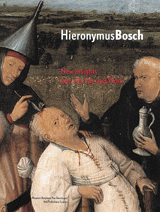
Elsig 2001
“Hieronymus Bosch’s Workshop and the Issue of Chronology” (Frédéric Elsig) 2001
[in: Jos Koldeweij, Bernard Vermet and Barbera van Kooij (eds.), Hieronymus Bosch. New Insights Into His Life and Work. Museum Boijmans Van Beuningen-NAi Publishers-Ludion, Rotterdam, 2001, pp. 96-101]
Basing himself on the appearance of the name Jheronimus Bosch in documents shortly after 1500 and on a document from 1503/1504 which refers to Bosch’s collaborators (the so-called Knechten-document), Elsig states that Bosch’s workshop seems to have been founded in the first years of the sixteenth century. He proposes to divide its output into four groups.
The first group comprises the Bruges Last Judgment triptych (Groeningemuseum) and a Virgin and Child panel that surfaced on the French market in 1989 (see illustration 11.2 on page 98). These two works show stylistic links to the Temptations of St. Anthony triptych (Lisbon) and can be dated around 1500-1505. The second group is centered on the Ecce Homo triptych (Boston) and further comprises the Tabletop of the Seven Deadly Sins (Madrid) and the Earthly Paradise panel (Chicago). These works refer to the Garden of Delights triptych (Madrid) and are dated by Elsig around 1510. The third group can be linked to the Adoration of the Magi triptych (Madrid) and is dated by Elsig in the second decade of the sixteenth century. This group comprises the Adoration of the Magi triptych (Anderlecht) en the Job triptych (Bruges).
The fourth group (to be dated in the early twenties of the sixteenth century) comprises a number of paintings attributed by Elsig to Gielis Panhedel, nicknamed Gielis van den Bossche, who was probably one of Bosch’s assistants. To this group belong the Salomon and Batsheba and David and Abigail panels (current location unknown), the Christ and the Woman taken in Adultery panel (Phildadelphia), the Christ among the Doctors panel (Opocno), the Wedding at Cana panel (Rotterdam) and the Adoration of the Child panel (Cologne). The Conjuror panel (Saint-Germain-en-Laye) and the Concert in the Egg panel (collection Balny d’Avricourt, the Lille version is a younger variation) could be youthful works by Panhedel and may reflect Bosch’s original ideas. The Conjuror copy in a Californian collection is, according to Elsig, and early twentieth-century forgery.
From these four groups Elsig derives three periods in Bosch’s stylistic evolution: the first from about 1470 till about 1490, the second from about 1490 till about 1505 and the third from about 1505 till 1516. Regarding Bosch’s influence in the sixteenth century it is imperative to draw a clear distinction between works produced by his workshop and those painted by his followers. These latter works can be divided into two groups. The first group, centering around Jan Mandyn and Peter Huys, reinterprets Bosch’s iconographic repertory in its own mannered style. The second group produces pastiches of Bosch’s works, sometimes bordering on forgery.
Unfortunately Elsig’s arguments in this contribution are rather superficial and often obscure. For a better evaluation of these arguments it is necessary to read Elsig’s 2003 monograph (see Elsig 2003).
[explicit]